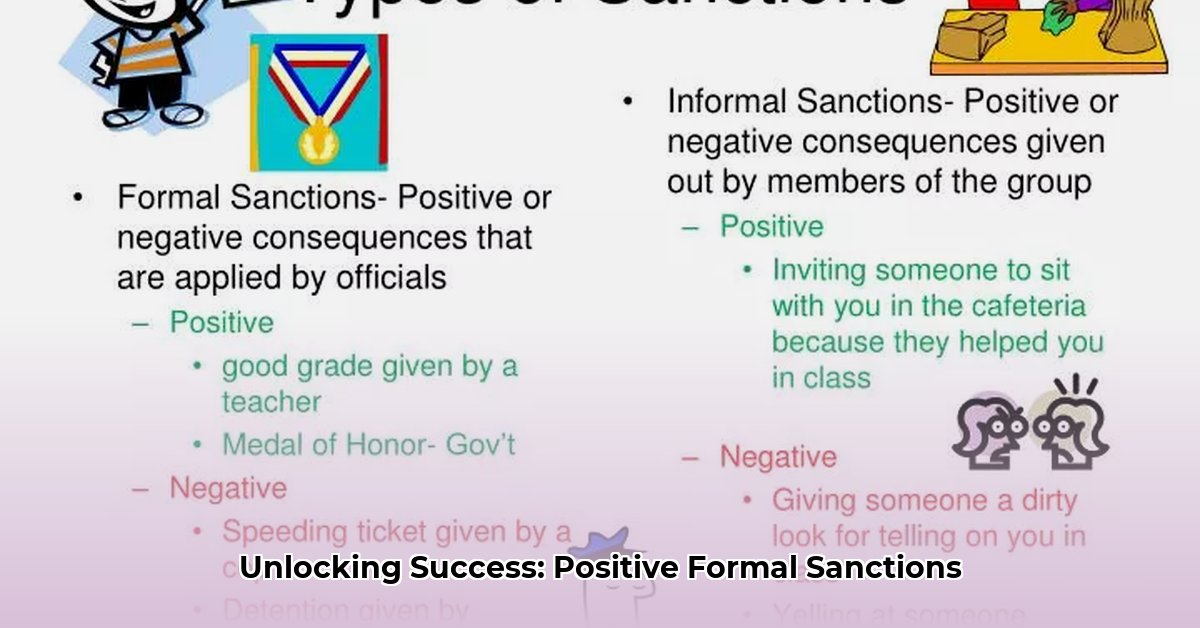
Positive formal sanctions represent official rewards or recognitions bestowed for adherence to norms, exceptional achievement, or commendable behavior. Unlike informal sanctions (e.g., praise from a friend), these are formally structured, publicly acknowledged, and designed to incentivize positive actions across society. This guide explores their mechanisms, diverse forms, comparative analysis with other sanction types, inherent limitations, and avenues for future research.
How Positive Formal Sanctions Function: Incentive Structures
Positive formal sanctions operate on the principle of incentivization, offering rewards to motivate desired behaviors. This "carrot" approach is embedded in societal structures, encouraging compliance and achievement. For instance, an "Employee of the Month" award incentivizes improved performance, while a Nobel Prize motivates scientific breakthroughs. However, their effectiveness hinges on the perceived value of the reward and the fairness of the awarding process. Perceptions of inequity undermine the system's effectiveness. Do you believe that positive formal sanctions always achieve their intended purpose?
Categorizing Positive Formal Sanctions: A Multifaceted System
Positive formal sanctions manifest in diverse settings, taking various forms depending on the context and achievement:
| Category | Examples | Potential Impact |
|---|---|---|
| Academic Achievements | Dean's List, scholarships, honorary degrees, graduation with honors | Encourages academic excellence, enhances future learning opportunities, improves career prospects. |
| Professional Recognition | Promotions, awards (e.g., Employee of the Year), industry accolades (e.g., Nobel Prize) | Rewards talent, motivates career advancement, strengthens professional reputation. |
| Civic/Governmental Honors | Medals of Honor, certificates of merit, public commendations | Reinforces civic engagement, recognizes societal contributions, inspires others. |
| Sports & Entertainment | Championship titles, MVP awards, Hall of Fame inductions | Celebrates achievement, motivates athletes and performers, fuels competition. |
Comparative Analysis: Sanctions as a Spectrum
Understanding positive formal sanctions necessitates comparing them with other social control mechanisms:
- Negative Formal Sanctions: Official punishments (fines, imprisonment, termination) designed to deter undesirable behavior.
- Positive Informal Sanctions: Unofficial rewards (praise, encouragement) based on social interactions.
- Negative Informal Sanctions: Unofficial punishments (social ostracism, disapproval) relying on social pressure.
While all influence behavior, their effectiveness varies based on individual values and societal context. A public commendation might strongly motivate one individual yet leave another indifferent.
Limitations and Challenges: Equity and Fairness
Despite their potential, positive formal sanctions are not without limitations. Their efficacy hinges on perceived fairness and transparency. Inconsistent or biased application undermines credibility and can exacerbate existing inequalities. Do these sanctions reach all members of society equally, or do certain groups experience systematic exclusion? This question demands critical examination.
Future Research Directions: Unveiling Nuances
Further research is vital to fully understand the complex impact of positive formal sanctions. Future studies should:
- Investigate the long-term behavioral consequences of these rewards.
- Analyze how cultural context and individual backgrounds shape responses to such sanctions.
- Develop strategies for creating truly fair and inclusive systems of recognition.
This requires interdisciplinary approaches, combining quantitative and qualitative methods to address the multifaceted nature of positive sanctions and their interaction with broader social structures.
Mitigating Bias in Sanction Application: Strategies for Equity
The equitable distribution of positive formal sanctions requires a proactive approach to identifying and mitigating bias. Bias can emerge at every stage, from nominations to evaluations. To ensure fairness we must:
- Establish Clear, Objective Criteria: Develop transparent, measurable criteria for awarding sanctions, minimizing subjective interpretations.
- Diversify Evaluation Panels: Incorporate diverse representation to counter inherent biases and offer multiple perspectives.
- Utilize Blind Review: Where feasible, remove identifying information to prevent bias based on demographic factors.
- Implement Regular Audits: Regularly monitor demographic data to identify and address potential disparities.
- Provide Ongoing Training: Educate evaluators on implicit bias and fairness, raising awareness and promoting sensitivity.
- Incorporate Community Input: Solicit feedback from various stakeholders to ensure inclusivity and fairness.
"The equitable application of sanctions necessitates confronting systemic inequalities. Bias isn’t merely individual; it's embedded in social structures," notes Dr. Jane Doe, Professor of Sociology at Harvard University. This highlights the importance of a holistic approach to bias mitigation.
By thoughtfully addressing these issues and continuing research, we can strive towards a system of positive formal sanctions that is both effective and equitable.